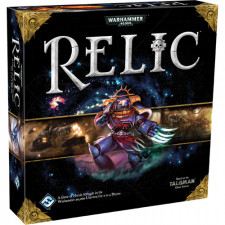Relic Review
on Jul 28, 2015
I genuinely enjoy roll-and-move games. You can put down the pitchforks: I don’t care for Monopoly or Pachisi, but a good adventure game that can play to the strengths of the mechanism sounds like a great afternoon to me. A well-done game in the genre provides a quick, dynamic pace for the players, as the die roll can generate the type of encounter or action the player will execute as well as hurtle him toward his goal. These games are often more story-driven than their German-style counterparts, and players have to know they’re more passenger than conductor for the duration of the game. But for gamers who can lighten up a bit, a dice-heavy roll-and-move adventure game might be just the ticket.
Thirty years ago, Talisman was all the rage for this kind of game enthusiast. In a day when designers always seemed to assume you had eight hours to run through a simple adventure game with your friends every weekend, it was the perfect light design. Now that we’ve found ourselves faced with seemingly less and less time to play games and a constant barrage of ever-more-complex strategy games, Talisman is starting to look a little less appealing on the game shelf. And so, with the concerns of the modern gamer in mind, FFG has revamped the system with Relic, a complete overhaul that nonetheless retains what made the original fun decades ago.
What makes Relic so mesmerizing is that it provides a great sense of progression, far beyond the simple leveling aspect of Talisman before it. The characters will start out as space-going peons, losing easy battles to weakling Orks and simple skill tests. But gradually, the benefits of each level gained will kick in. The journey through the first couple levels can be a chore, but suddenly everything clicks, and your character feels like a force for the 40K universe to reckon with. Since each character levels slightly differently, gaining different boons and boosts along the way, every game won’t be the same mindless grind up the levelling ladder.
Another major improvement comes in the form of Mission cards. Rather than relying on luck alone to help you acquire the all-powerful Talisman, Relics are gained by accomplishing missions in service of the Emperor. These are fairly well varied and help focus players’ actions to something more concrete than just a general goal to improve and eventually tackle the big bad. In addition, through the use of three separate Threat decks, players can hone in on the skill they need to improve or the battles they’re most likely to win, meaning more encounters over the course of the game will be helpful rather than total crapshoots.
The ebb-and-flow of gameplay is addicting, for the most part. Talisman has always been about simple resource management: do I use my one-off spell card now, or save it for a more deadly foe? Do I cash in for a level now, or wait until I won’t be wasting leftover points from the enemy cards? Building up resources and then blowing them on a crucial battle is all part of the dynamic flow of play. Relic adds just enough subsystems and resources to keep players all the more occupied--enough that they won’t feel the sting of the game’s more brutal random elements. Managing varied assets like allies, weapons, Power cards, Threat cards, Influence, charge tokens, missions, and of course Relics is a fun diversion and helps players deal with the cold, hard randomness the game thrives on.
From a broader strategic perspective, Relic is all about timing. No matter what the outcome of all the tiny decisions throughout a game session, the crucial moment comes about three-quarters of the way through a play. Players will feel about 80% sure they can make it to the center and accomplish the objective. The game will sorely tempt them to keep on beefing up their characters until they’re 100% sure they can win, but the player that can resist the urge to grind too much will dash for the objective and win most of the time. Cross your fingers, take a deep breath, and run for the center, and you’ll usually be pleasantly surprised by the outcome.
Relic improves upon Talisman in everything it tweaked, but unfortunately a few elements were left untouched. The board is still a Monopoly-inspired, abstract set of squares that don’t really suggest any spatial relationship among the spaces. This lack of a sense of place can really hurt the otherwise rich Warhammer 40K setting, which is masterfully illustrated and narrated on all of the cards and locations. Cards will tell you to go to a particular space station or world, but you’ll still have to squint at board text to even figure out where that is, since they’re primarily unrelated squares pasted next to each other. Yes, there’s a general thematic connection among the spaces on each side of the board, but unless you’re a 40K fanatic you probably won’t find it very helpful. It’s not a huge issue, but I do find myself wishing FFG would have gone one step further and created a plausible universe map.
If you didn’t stop reading at “roll-and-move,†Relic might just be for you. With a greater sense of purpose, a more focused structure and pacing, and a slight nod toward modern sensibilities, Relic offers the best of classic adventure games in a more approachable, strategic design.

 Customer Support
Customer Support  Subscribe
Subscribe 




 Account
Account  Wishlist
Wishlist 

